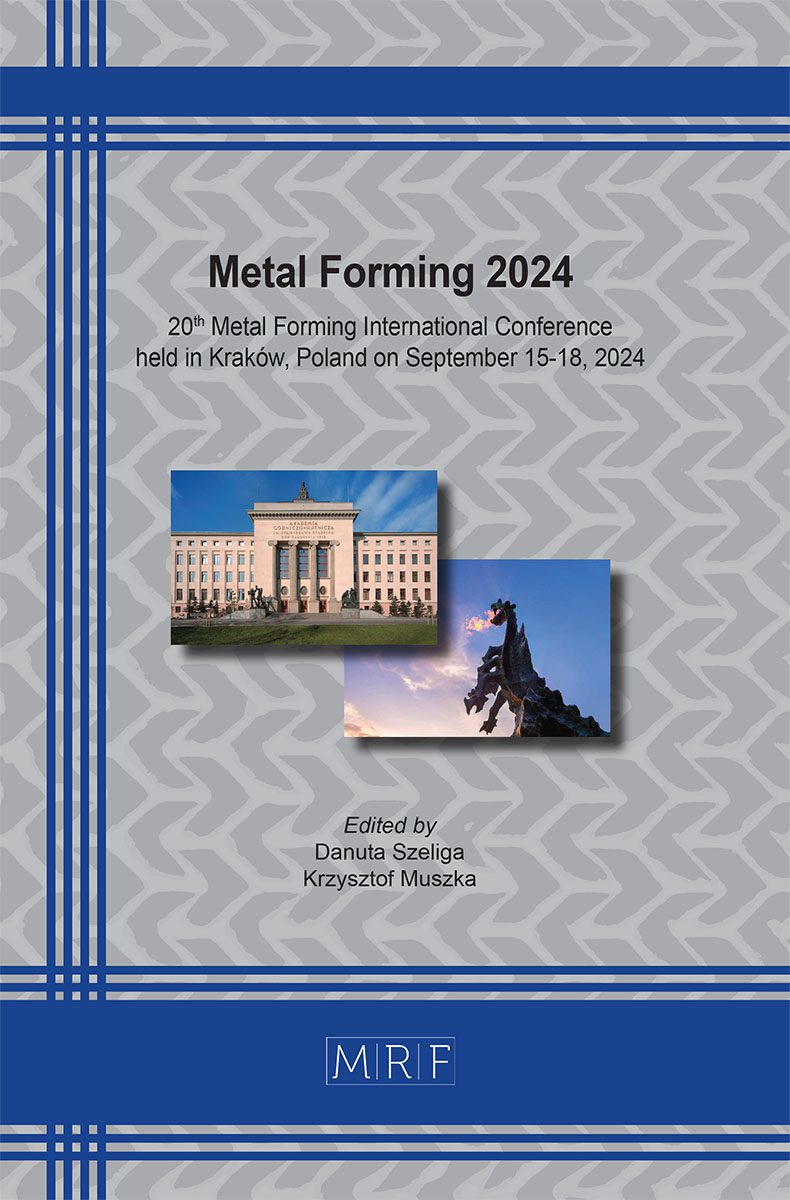–
Integrating Numerical and experimental analyses for the realization of pre-detection of delayed fractures on punched surfaces of ultra-high-strength steel sheets
UEDA Yuya, EGUCHI Jin, MATSUNO Takashi
download PDFAbstract. A key challenge encountered in finite element (FE) punching simulations is accurately capturing the arrest or delay in crack propagation during punch penetration. Conventional methods relying on element deletion demonstrate inadequacies in representing crack arrest, particularly complicating the simulation of the punched surface states in scenarios with minute clearances. This study introduces a novel approach for fracture representation in FE punching simulations, wherein cracks were integrated as perimeter lines during the remeshing process. Utilizing observation-driven crack propagation paths and arrest behaviors, we analyzed the residual stress on punched surfaces under minimal clearance conditions. Results indicate that for 22MnB5 hot-stamped steel, the residual stresses within the interior side of the burnished region can exceed 1 GPa in cases with a 10-μm clearance.
Keywords
Punching, Finite Element Simulation, Residual Stress
Published online 9/15/2024, 9 pages
Copyright © 2024 by the author(s)
Published under license by Materials Research Forum LLC., Millersville PA, USA
Citation: UEDA Yuya, EGUCHI Jin, MATSUNO Takashi, Integrating Numerical and experimental analyses for the realization of pre-detection of delayed fractures on punched surfaces of ultra-high-strength steel sheets, Materials Research Proceedings, Vol. 44, pp 597-605, 2024
DOI: https://doi.org/10.21741/9781644903254-64
The article was published as article 64 of the book Metal Forming 2024
![]() Content from this work may be used under the terms of the Creative Commons Attribution 3.0 license. Any further distribution of this work must maintain attribution to the author(s) and the title of the work, journal citation and DOI.
Content from this work may be used under the terms of the Creative Commons Attribution 3.0 license. Any further distribution of this work must maintain attribution to the author(s) and the title of the work, journal citation and DOI.
References
[1] K.-i. Mori, Y. Abe, K. Sedoguchi, Delayed fracture in cold blanking of ultra-high strength steel sheets, CIRP Annals, 68 (2019) 297-300. https://doi.org/10.1016/j.cirp.2019.04.111
[2] T. Matsuno, Y. Sekito, E. Sakurada, T. Suzuki, K. Kawasaki, M. Suehiro, Resistance of hydrogen embrittlement on hot-sheared surface during die-quench process, ISIJ Int. 54 (2014) 2369-2374. https://doi.org/10.2355/isijinternational.54.2369
[3] T. Matsuno, N. Kinoshita, T. Matsuda, Y. Honda, T. Yasutomi, Microvoid formation of ferrite-martensite dual-phase steel via tensile deformation after severe plastic shear-deformation, ISIJ Int. 63 (2023) 941-949. https://doi.org/10.2355/isijinternational.ISIJINT-2023-012
[4] M. Yoshino, Y. Toji, S. Takagi, K. Hasegawa, Influence of sheared edge on hydrogen embrittlement resistance in an ultra-high strength steel sheet, ISIJ Int. 54 (2014) 1416-1425. https://doi.org/10.2355/isijinternational.54.1416
[5] T. Matsuno, Y. Ueda, T. Takahashi, T. Hama, T. Hojo, Y. Shibayama, M. Ridha, Y. Okitsu, M. Takamura, Delayed fracture stress thresholds degraded by shear punching process in ultra-high-strength steel sheets: Analysis using an in-plane bending test with numerical assimilation, J. Manuf. Process. 119 (2024) 1005-1021. https://doi.org/10.1016/j.jmapro.2024.04.013
[6] T. Matsuno, Y. Ochiai, Y. Okitsu, M. Iga, A. Kohri, T. Mikami, Surface and interior residual stress analysis of a deep-drawn 1180-MPa class ultra-high strength steel sheet with scratch marks, Int. J. Adv. Manuf. Tech. 116 (2021) 2873-2884. https://doi.org/10.1007/s00170-021-07675-2
[7] T. Matsuno, K. Nakagiri, T. Matsuda, T. Tanaka, T. Yasutomi, H. Shoji, M. Ohata, Identification of ductile fracture design curve for hardened quasi-brittle AISI-D2 tool steel to predict shearing tool failure, J. Mater. Process. Tech. 307 (2022). https://doi.org/10.1016/j.jmatprotec.2022.117680
[8] T. Matsuno, A. Seto, M. Suehiro, Y. Kuriyama, H. Murakami, FEM analysis of high strength steel sheets up to fracture and its application to piercing process, Proceedings of IDDRG2012, (2012) 134-140.
[9] T. Matsuno, M. Takamura, S. Mihara, T. Koda, K. Tsujioka, Development of the crack-line-update method for two-dimensional piercing simulations, Journal of Physics: Conference Series, 1063 (2018) 012157. https://doi.org/10.1088/1742-6596/1063/1/012157
[10] T. Matsuno, T. Fujita, T. Matsuda, Y. Shibayama, T. Hojo, I. Watanabe, Unstable stress-triaxiality development and contrasting weakening in two types of high-strength transformation-induced plasticity(TRIP) steels: Insights from a new compact tensile testing method, J. Mater. Process. Tech. 322 (2023) 118174. https://doi.org/10.1016/j.jmatprotec.2023.118174
[11] T. Matsuno, D. Kondo, T. Hama, T. Naito, Y. Okitsu, S. Hayashi, K. Takada, Flow stress curves for 980MPa- and 1.5GPa-class ultra-high-strength steel sheets weakened under high-stress triaxiality, Int. J. Mech. Sci. 261 (2024) 108671. https://doi.org/10.1016/j.ijmecsci.2023.108671
[12] T. Matsuno, T. Hojo, I. Watanabe, A. Shiro, T. Shobu, K. Kajiwara, Tensile deformation behavior of TRIP-aided bainitic ferrite steel in the post-necking strain region, Sci. Tech. Adv. Mater.: Methods 1 (2021) 56-74. https://doi.org/10.1080/27660400.2021.1922207












